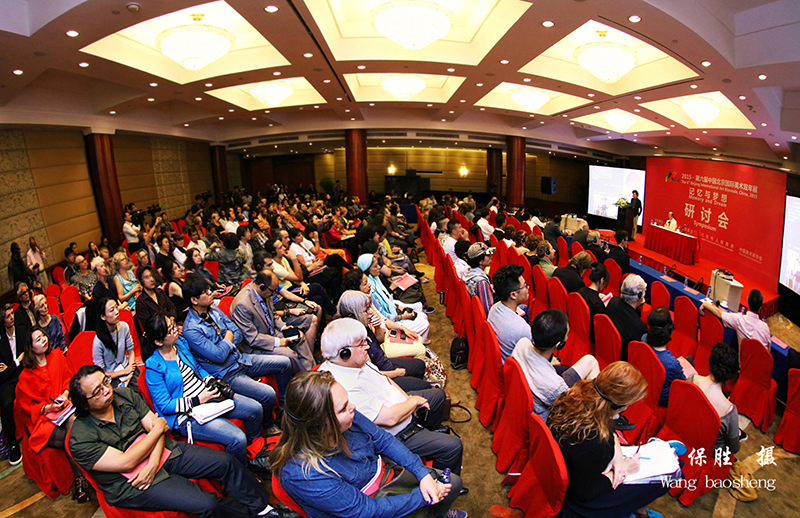
A Panorama of the Symposium
The “International Symposium of the 6th Beijing International Art Biennale, 2015 China” under the theme of “Memory and Dream” was held on September 25th at the Beijing International Hotel. Mr. Liu Dawei, Chairman of the China Artists Association attended and delivered a speech at the symposium. Mr. Shao Dazhen, Honorary Director of the Commission on Art Theory of the China Artists Association and Professor of the Central Academy of Fine Arts acted as the host-of- chief of the symposium along with Ms. Tao Qin, Vice Secretary General of the China Artists Association, Mr. Wang Yong, Research Scholar of the Chinese National Academy of Arts, Mr. Zhang Xiaoling, Vice President of the China National Academy of Painting and Mr. Ding Ning, Vice Dean at the School of Arts of the Peking University hosting parallel sessions. The symposium invited Shang Hui, Peter Hiers, Zheng Gong, Gary Stern and around 20 theorist and artist from home and abroad to deliver a speech on the theme of “Memory and Dream”. They all expressed their opinions and conducted a comprehensive discussion on contemporary art, the context of art creation, multiculturalism and the system of the Beijing Biennale. Over 200 people covering artists from all over the world, representatives from art institutions and media attended the symposium.At the first section of the symposium, Mr. Shao Dazhen generally introduced the 6th Beijing Biennale and mentioned that the numbers of participating countries and submissions registered a new height at this session. Beijing Biennale sticks to take contemporary paintings and sculptures as the main contents of its exhibition and accept a small number of installations, videos, mixed media and other new media art, which expresses its philosophy of the Beijing Biennale,that is, “Extension of the contemporary paintings and sculptures” . There are more special exhibitions than previous sessions, including the Special Exhibition of Southeast Asia, Special Exhibition of Canada etc. The artistic standard also surpasses the previous 5 Beijing Biennales. There are more artists in different countries to participate into the Beijing Biennale and their artworks all focus on “Memory and Dream”, the theme of the Beijing Biennale and present their exploration, interpretation of art. Besides, Mr. Shao Dazhen, quoted the evaluation of foreign media and artists as saying: The classic art expression should not decline as a result of the appearance of new-media art. China provides a pivot for the international community. The global contemporary art which oriented in European countries and America, will change its structure as the development of art in China. As a result, the philosophy of Beijing Biennale has a bright prospect in the future.
Then, Mr. Liu Dawei, Chairman of the China Artists Association extended his warm welcome for all the artists and theorists who came along to the symposium, briefly introduced the 6th Beijing Biennale and made a deep interpretation of the theme of the academic symposium. He pointed that: “The theme of “Memory and Dream” is inclusive and easy to perform. When artists make art creation, the theme extends a vast space for their imagination and present contemporary paintings and sculptures from all over the globe. The memory and dream is precious for individuals, communities and nations. The human civilization moves forward on the basis of memory and dream.
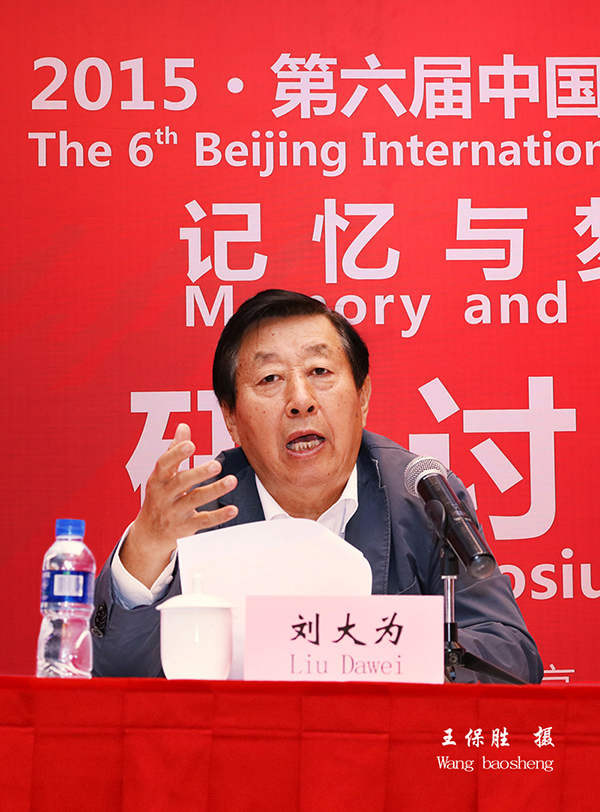
Mr. Liu Dawei, Chairman of the China Artists Association is delivering a speech
Every person has his or her own dreams. Artists are excellent dream catchers. Artistic activities, as human’s mental behavior is definitely within the boundary of memories, realities and dreams. Dreams are aspirations of human beings, hopes to put an end to disasters, prospects to pursue happiness and objectives for hard work. When artists try to express dreams by means of art, it will serve as their creative and appealing mental indication and pursuit.
At present, China is on the track of realizing its dream of great rejuvenation, which expresses the spirit of inclusiveness. It stands for harmony and happiness of the Chinese people and also advocates “community of common destiny for all mankind”, that is, to share the achievements of China with the world and to pursue for a beautiful vision. He quoted Ms. Theobald, an official in charge of the international non-governmental organizations of the UNESCO as saying: Beijing Biennale displays the developments of the contemporary art of China and provides a platform for international artistic exchanges in terms of its colorful, abundant and wonderful artworks. Mr. Liu Dawei thinks that, Beijing Biennale plays a significant role in cultural diversity, mutual understanding and cultural dialogues of visual art and the theme of the Beijing Biennale coincides of the “Chinese Dream”.
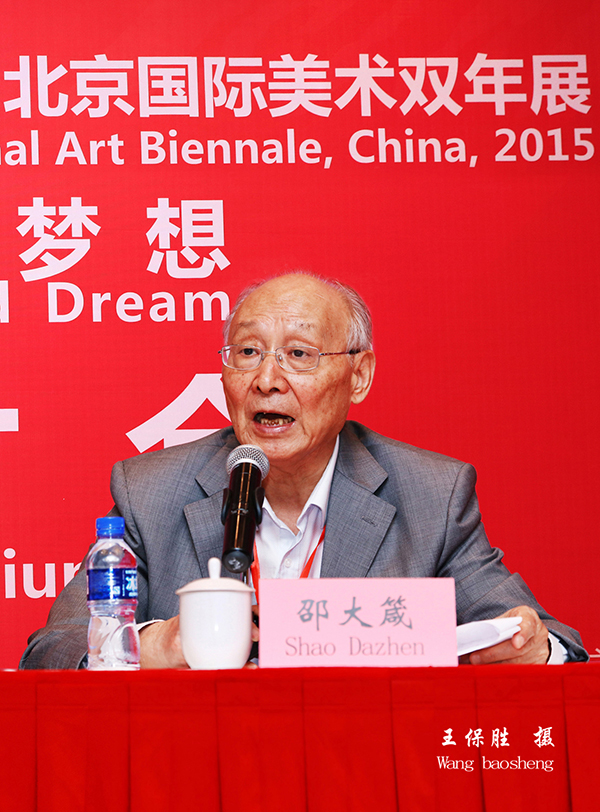
Mr. Shao Dazhen, Professor of the Central Academy of Fine Arts acted as the host-of- chief of the symposium
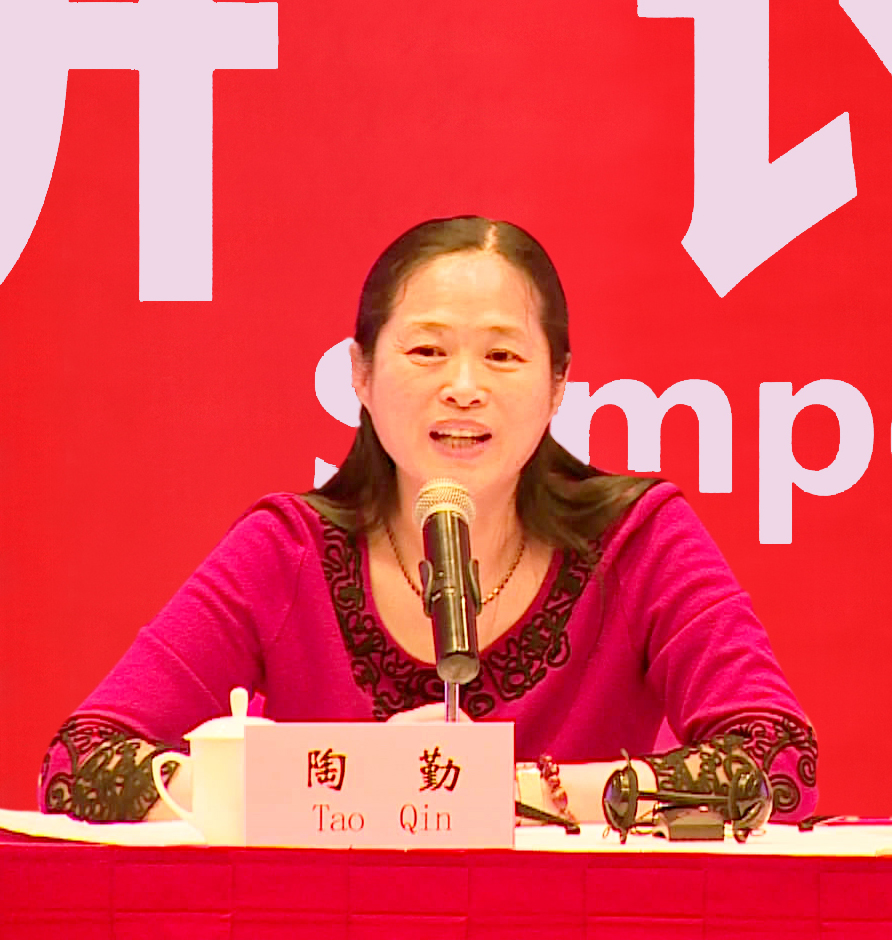
Ms. Tao Qin, Vice Secretary General of the China Artists Association acted as a host of the parallel session
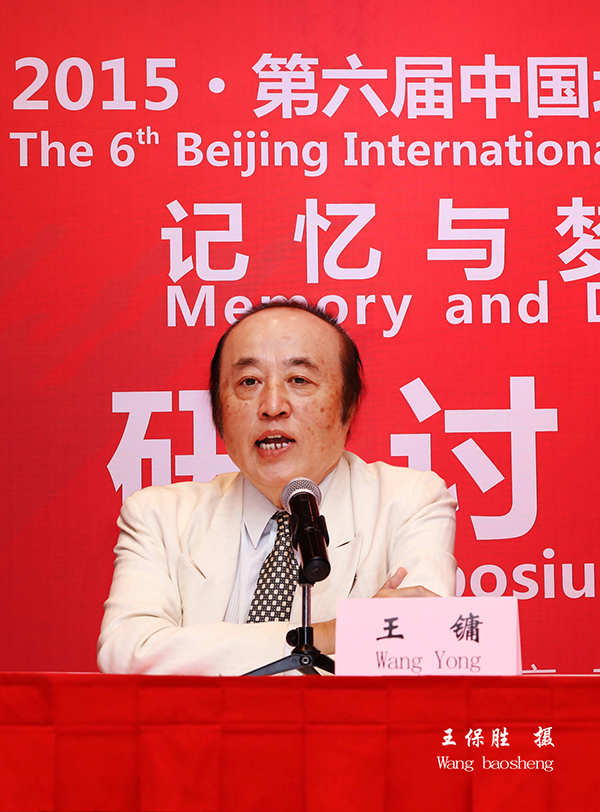
Mr. Wang Yong, Research Scholar of the Chinese National Academy of Arts acted as a host of the parallel session
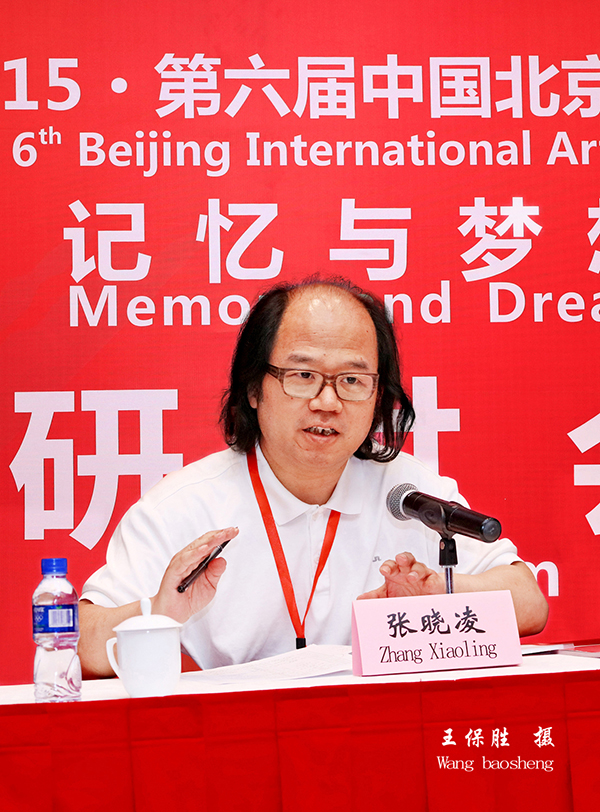
Mr. Zhang Xiaoling, Vice President of the China National Academy of Painting acted as a host of the parallel session
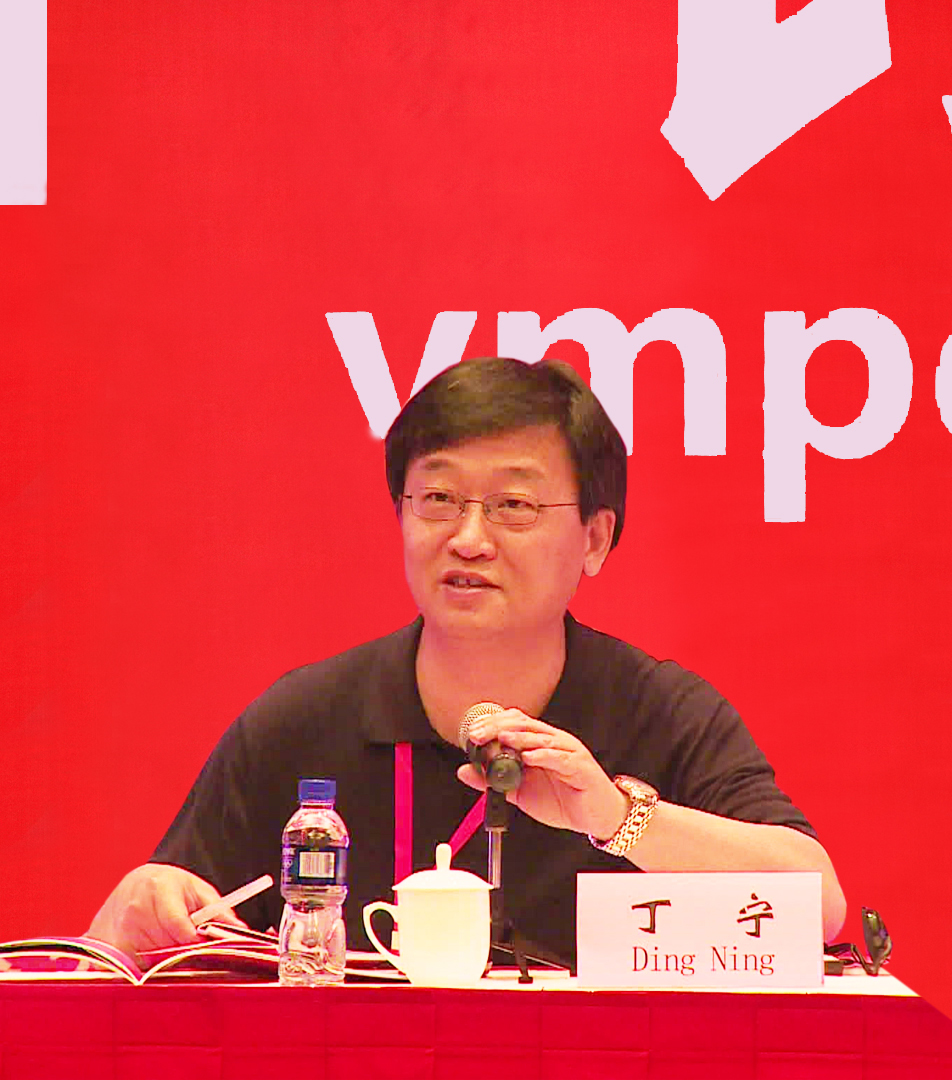
Mr. Ding Ning, Vice Dean at the School of Arts of the Peking University acted as a host of the parallel session
China’s Art Development Moves onShang Hui, Executive Chief Editor of Art Magazine by China Artists Association took Chinese Contemporary Arts: Plastic Arts as the Main Body as the theme of his speech and expressed his point of view: “The new image consumption pattern resulting from network information in a post-modern society has largely changed the existing definition about art. Almost all art production and consumption in contemporary society have experienced subversive changes. Different from contemporary art created by popular new media, such as action, device, concept and image, Chinese indigenous art education, art creation, and art concepts still uphold Chinese painting, oil painting, prints, watercolor paintings, lacquer paintings, ceramic crafts and sculptures, despite the fact that a lot of contemporary and modern Chinese artists have actively participated in international biennials. It shows that easterners have our own special and persistent cognition on artistic concepts; moreover, it also shows the intelligent creations of Chinese artists and the development of plastic arts in the image era. Chinese artists neither think that “the end of easel painting has come” nor lose confidence in the sustainable development of easel painting.”

Shang Hui, Executive Chief Editor of Art Magazine by China Artists Association is delivering a speech
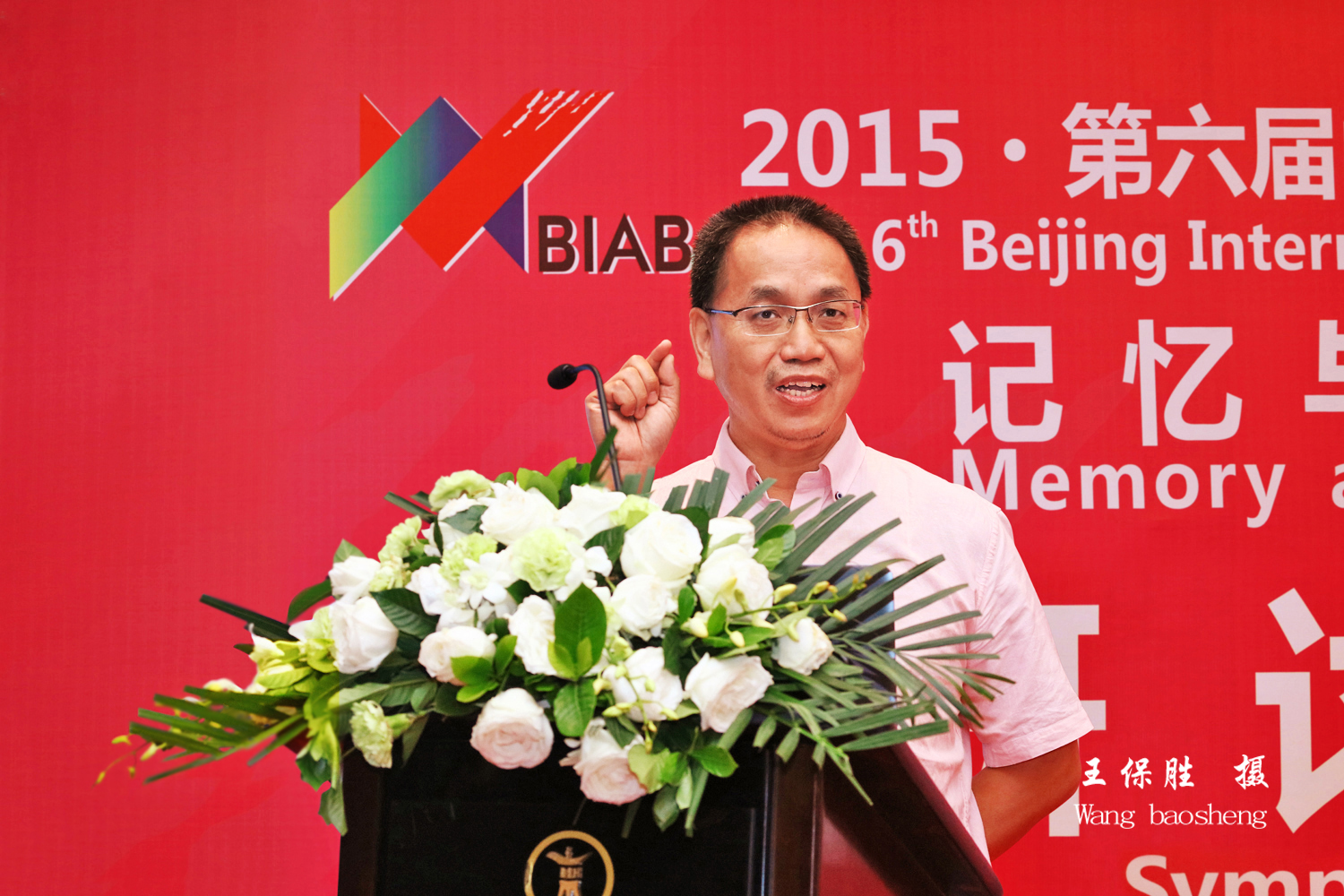
Zheng Gong, Vice Director of the Research Institute of Art under the Chinese National Academy of Arts is delivering a speech
Zheng Gong, Vice Director of the Research Institute of Art under the Chinese National Academy of Arts took Chinese contemporary experimental art as the theme of his speech. Excerpt from his speech is as follows: “Chinese contemporary experimental is now 30 years old. Contemporary experimental art pays more attention to newly-emerged media forms such as devices, images, behavior or the Internet. Based on the language of reform practice, artists intend to make full breakthroughs in and seek all possibilities of expression; they have a strong consciousness to address problems. There is no doubt that Chinese contemporary experimental art has been influenced by western contemporary art, but more importantly, it highlights Chinese problems and values Chinese cultural elements. These artists express their concerns with reality through sensitivity and intelligence. Their works, which feature being conceptual and visually influential, are thought-provoking. The specialty of contemporary experimental art in illustrating different kinds of special relations plays a significant role in the development of Chinese contemporary art.”

Zhang Gan, Vice Dean of Academy of Arts & Design of Tsinghua University is delivering a speech
Zhang Gan, Vice Dean of Academy of Arts & Design of Tsinghua University took The Western Origin of Chinese Contemporary Arts as the theme of his speech and excerpt from his speech is as follows: “Learning from Western art began from the early 20th century. For social, political and aesthetic reasons, Chinese artists chose academic art of the realistic style, represented by Xu Beihong’s works, instead of the modernist style, which was represented in works by Lin Fengmian. After the birth of New China, Chinese artists were very much influenced by Soviet socialist realist art and the dominant role of realist art in China was then established. Chinese contemporary art has undergone changes in theme and form, and concept exploration; in the end, the self-awareness and independence of the language of art have been realized. However, we can never deny the significant role played by western modernism, postmodernism and contemporary art in the liberation of contemporary Chinese art concepts.”
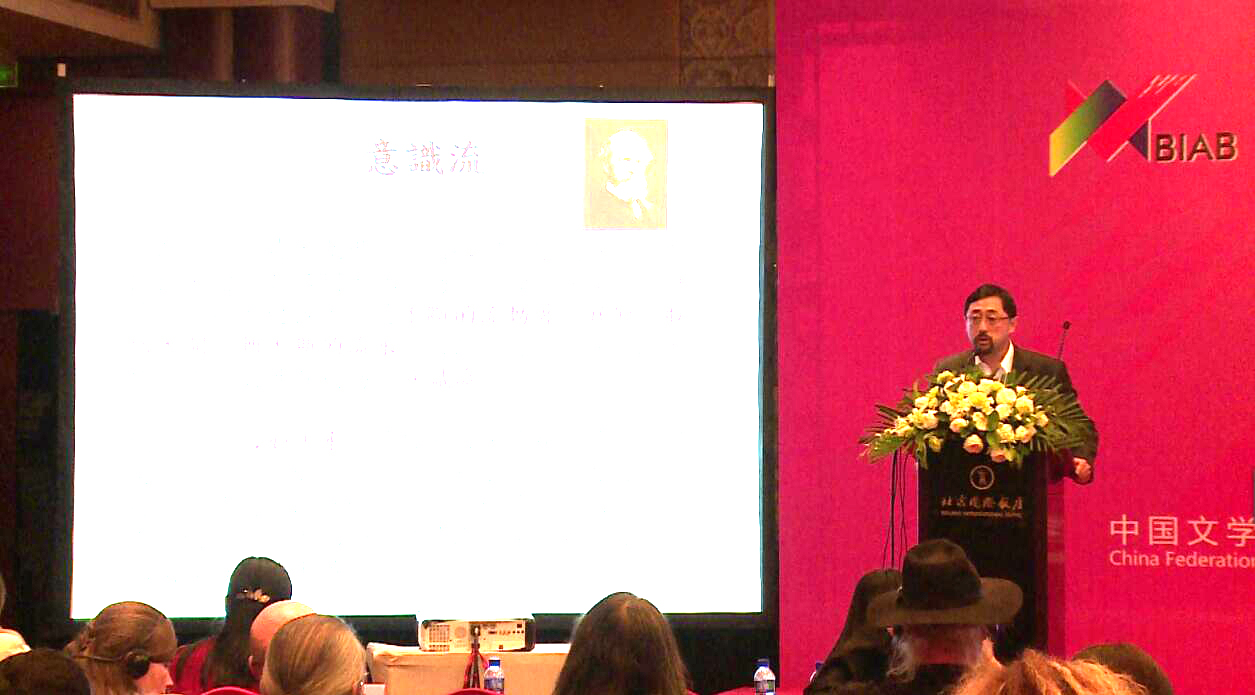
Wu Gangyi, Doctor of Art History at the China Central Academy of Fine Arts
Wu Gangyi, Doctor of Art History at the China Central Academy of Fine Arts is from Taiwan and he took The recreation and globalization of “Chinoiserie”: An international art dialogue on the “Chinese Dream” as the theme of his speech and excerpt from his speech is as follows: “The saying “what is more national is more international” is often quoted in the 21th century. The inherent theory is that “nationality” often leads to a cultural renaissance. However, in the field of art, the word “nationality” seems to be too general and indistinct. So, “Chinoiserie” is used to define the elements of nationality in the field of art. To start a new era of Chinese art, recreating and globalizing “Chinoiserie,” we need to absorb and integrate western culture from a variety of aspects and further explore and promote Chinese culture. Traditional Chinese culture is not old-fashioned or out-of-date, but instead needs to be further promoted. We need both a cultural renaissance in China and the promotion of our culture to the whole world. Moreover, based on a combination of an inheritance of traditional Chinese culture featuring “Chinoiserie” and the introduction of global art and culture, we need further development.”
Memories of Humankind and Dreams of Art
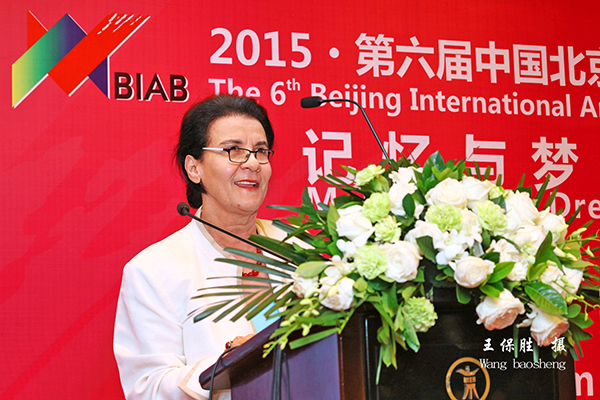
Kawther El-Sherif from Egypt is delivering a speech
Kawther El-Sherif, who is also the wife of the former Egyptian ambassador to Bahrain expressed her gratitude to the organizing committee of Beijing Biennale. In her speech The Role of Art in a Changing World, she said: “My paper refers to a number of art theories developed and advocated through ages such as theory of art for art, or art for society, or art for change. In essence the theory of art for a change is an art for a dream. The later theories indicate the overwhelming influence of the surrounding that make change is an object for every person`s work. Nevertheless, the close relationship and mutual influence have not get the focus they deserve. We the people of the world have a dream for peace to be prevailing everywhere in the globe. China has a similar dream pronounced by XI Jinping the president of the country since 2013. Chinese Society`s impact on art through the concept of Dream for a better, peaceful and prosperous world is felt in every corner of the globe. Today, Egyptians also have a Dream for peace, prosperity and stability. This is highlighted by the support of millions of people to the change that took place in June 30, 2013. However, we must know that time is needed to achieve dreams and expectations of the people.”
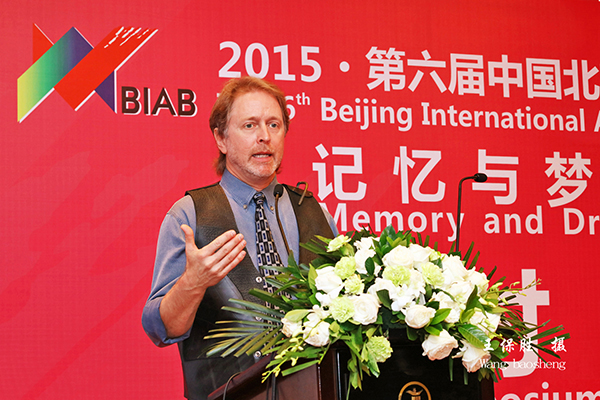
Peter Hiers, a sculptor from America is delivering a speech
Peter Hiers is a frequent artist in Beijing Biennale and has attended the symposium for several times. This time, the theme of his speech is Cultural Dreams, Nightmares and My Dream for the Future. Excerpt from his speech is as follows: “In my native country of the United States, there is a common ideology called “the American Dream” in which the pursuit of material success is the path to fulfillment and self-worth, a dream which has spread around the globe. This dream is based in a false myth that having “more, bigger, better, quicker, faster, easier for me now” will somehow lead to personal satisfaction and self-worth. My own dreams are different from these nightmarish scenarios. I dream of a world in which all people have material comforts necessary for individual survival. While there are many benefits to achieving levels of material comfort, there are also deeply troubling long-term consequences of endless consumerism, consequences which can have nightmarish effects on the ultimate survival of all humans, along with many other life forms. Depletion and degradation of our survival resources has dire consequences. I hope equilibrium can be achieved between what we take from and what we renew with our life-sustaining resources. Perhaps most importantly, I dream that people will find their own self-worth and sense of fulfillment from within themselves, rather than chasing the false-substitute of acquisition. Can we all find our dreams of personal self-worth from within ourselves, rather than from endless material pursuits? Isn’t that where personal fulfillment can be found anyway? This is the Shared Dream I hope to see evolve from the selfish and cumulatively destructive trajectory of the ‘American Dream.’”
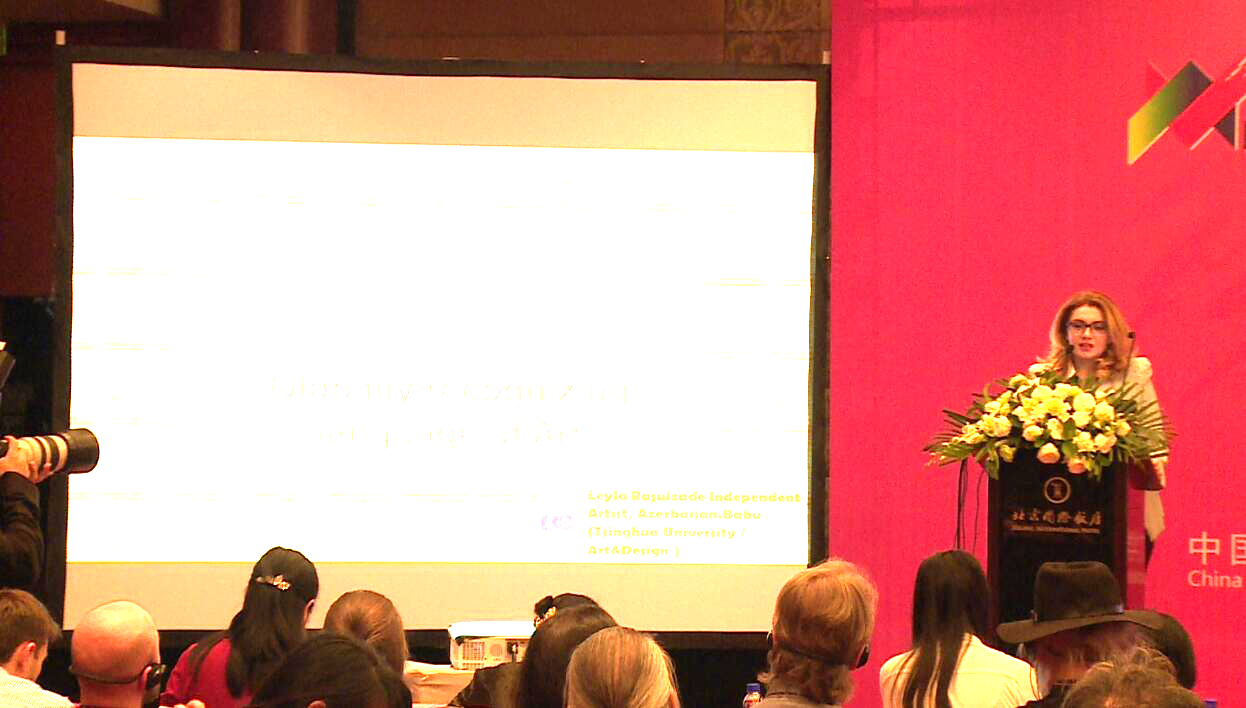
Leyla Rasulzade, an artist from Azerbaijan is delivering a speech
Leyla Rasulzade is an international student in the Academy of Arts & Design of Tsinghua University. She took Dialogue on Chinese Dream: Globally Recognizing Language of Art as his subject and expressed: “My Drea” began years ago in Beijing. On 2007, I remember clearly the very first small painting I produced while having emotionally troubled times on orienting around the big city of bright lights with strong history attached to it. As Chinese local plumbers arrived to fix water filters in my flat, I passed with cup of tea in my hand to realize that one of them is standing face-to-face with my little painting and looking at it in sadness. As he turned to me and said the Chinese words smiling quietly: ‘不错’ (pinyin: bu zuo), I realized how I finally succeeded to speak in universal language of Art. If my art could speak for itself, then I was on the right path. Art Biennales are very important platforms for today’s young artists. Not only can we have a chance to expose our paintings and our philosophies, our multi cultures and our individual concept of understanding the world around us, we embrace the culture of the present Biennale itself.”
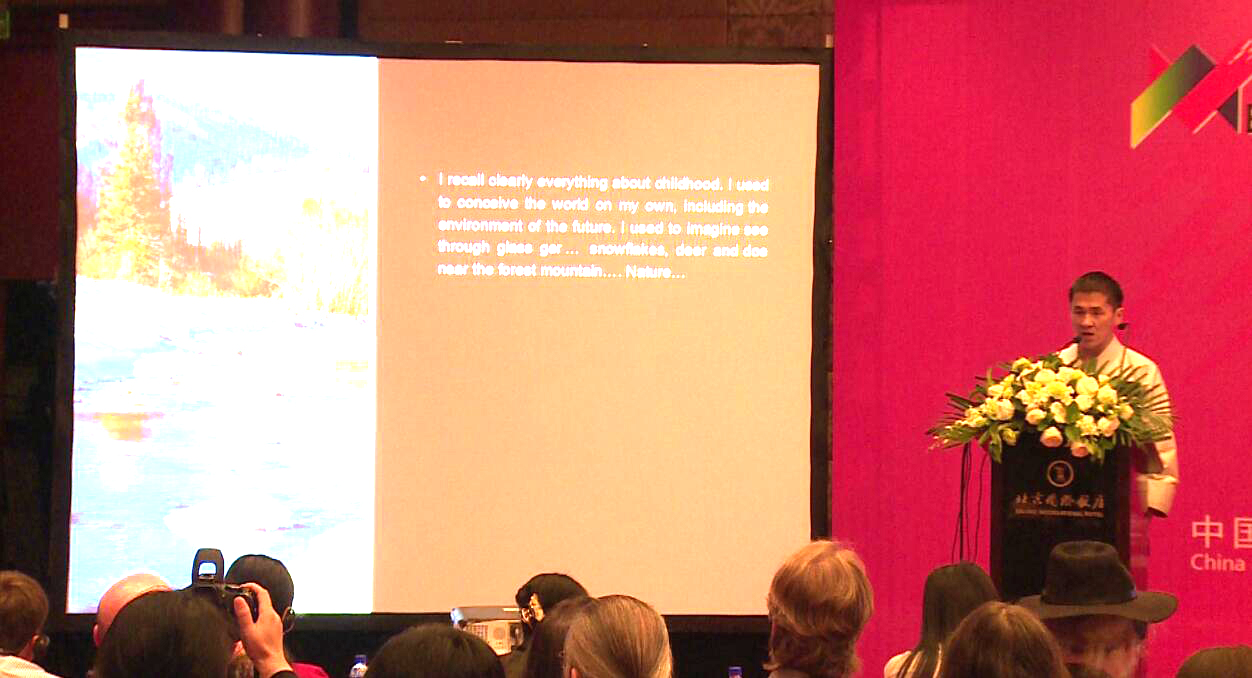
Battur Tsedenpil, a teacher from School of Art of Mongolian State University of Arts and Culture is delivering a speech
The theme for Battur Tsedenpil, a teacher from School of Art of Mongolian State University of Arts and Culture is My Memory is Human Beings and Nature, My Dream is Human Beings and Nature. The following is excerpt from his speech: “As I grew up older, I learned to respect and preference traditional art, culture and history. I believe that if we, Mongolians can keep our legacy, root, language and our traditional culture and inherit these to our descendants, Mongolians can keep our culture in this world for centuries and keep our nature originally and to make our descendants understand about legacy, language and traditional culture. This belief affects my art works and I describe Mongolian people’s life and enrich it with my own philosophy in my art work as an “interrelation of human beings and nature.” My art works are inspired by nature’s breathtaking beauty and it accomplished with imagination of connection between nature and human beings. I try to describe human beings’ feeling of certain time and place. Although, many Mongolian people are moving to the city to live, I know that most of them love to go to countryside if they have a chance. The main content of my speech shows how nomadic Mongolians inhabit in the city, how artists worry about that issue and why artists aspire to the nature…No one can imagine that what level of spectacular humankind can reach in thousands or billions of years with their “dream” and “aspiration” to the dream. I worry about that my, your or our culture, legacy, native customs and nature will fade into this limitless time and expansion. That’s why I always put aspiration into my art work to give a message to everybody that we have to keep our culture, legacy and nature, no matter what nationality we are.”
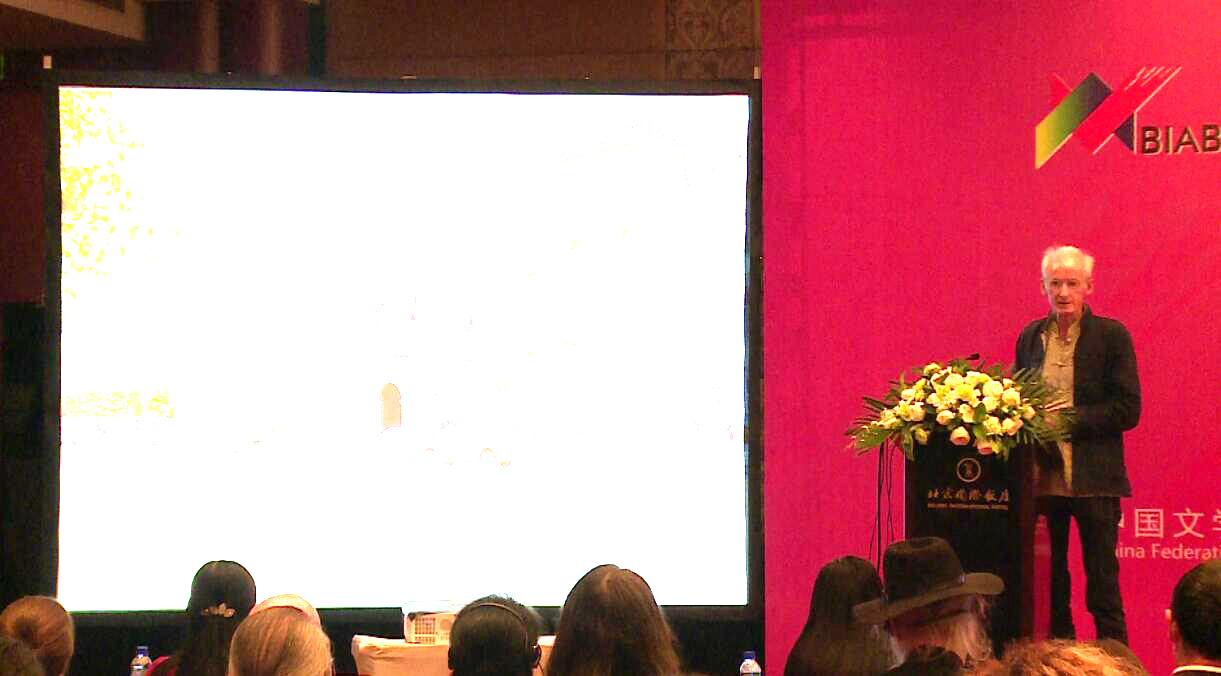
Pontus Kjerrman, Associate Professor at the Sculpture Department of the Royal Danish Academy of Fine Arts is delivering a speech.
Pontus Kjerrman, Associate Professor at the Sculpture Department of the Royal Danish Academy of Fine Arts was inextricably bound up with China since long ago and he told his story in The Chinese Dream in My Art:As a young boy in Gothenborg in Sweden I was given a copy of the diary that Wulff kept during his trip to China. I read a lot about the history of China. In 1968 I started studying Chinese language and culture as a visiting student at the University of Gothenburg. One day, we went to visit the site of Yuan Ming Yuan, the Old Summer Palace, which was looted and burned to the ground in 1860. In a part of the garden, you can see the ruins of some palaces that were built in the seventeenth century and designed in an occidental Chinese version baroque style, along with the dashuifa, a large fountain that contained the 12 zodiac animals, which served as such an inspiration for me, by virtue of what I, with my “Western” eyes, perceive as their naive joy and their deep wisdom. Later I travelled to China with my wife, son and daughter and visited the Jinci Temple in the province of Shanxi, which inspired us to design the doors for the gate of Tine’s new studio as we eventually made them.
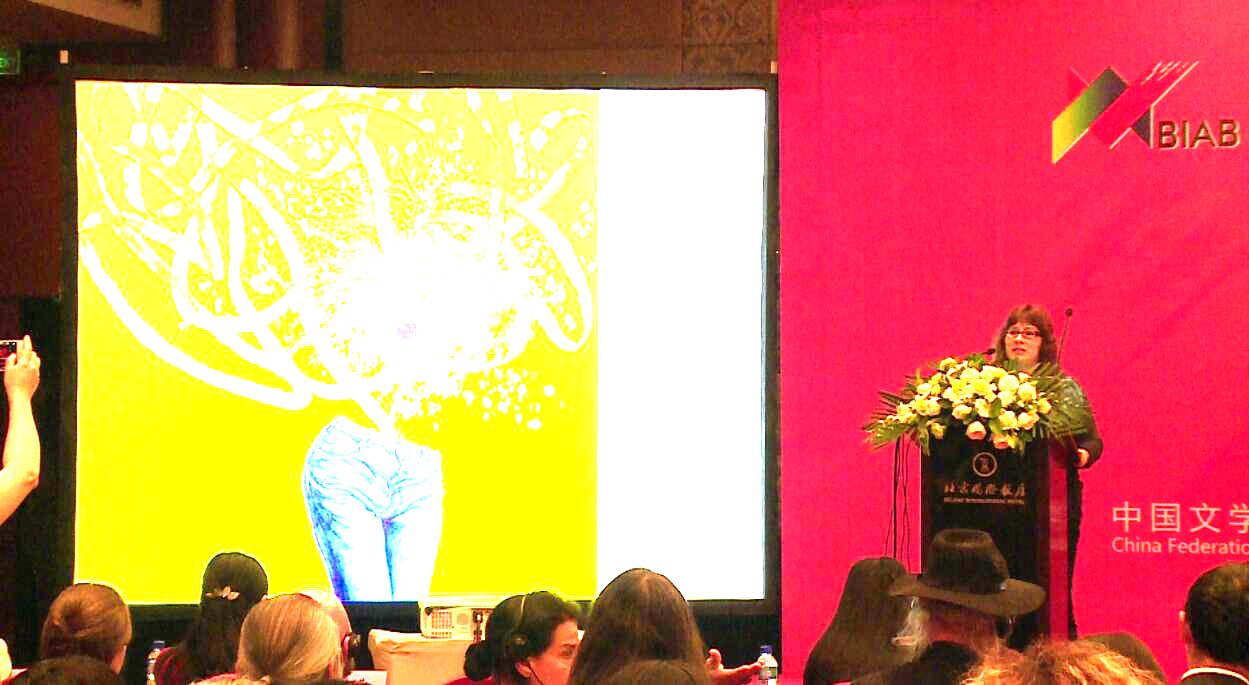
Jacqueline Rodriguez, Professor of University Catholic of Peru is delivering a speech
Jacqueline Rodriguez, who is a Professor of University Catholic of Peru showcased her understanding of art in her own artworks. In her speech The Journey of Memory, she expressed: “The journey of memory is always evolving, in short or long term. It enables us to seal our lives, to recognize, store and evoke feelings, ideas, images and experiences which are transmitted from generation to generation. Art and memory have much in common. Together they manage this transition from the material to the spiritual. They preserve, transmit and disseminate, can be revalued or reinterpreted, showing the possibilityof an infinite reading. Many artists resort to nature as a source of inspiration and reflect it through their works. We create an imagined ideal that enriches our lives and communicates a new meaning, a centrifugal project, which expands into the universal.”
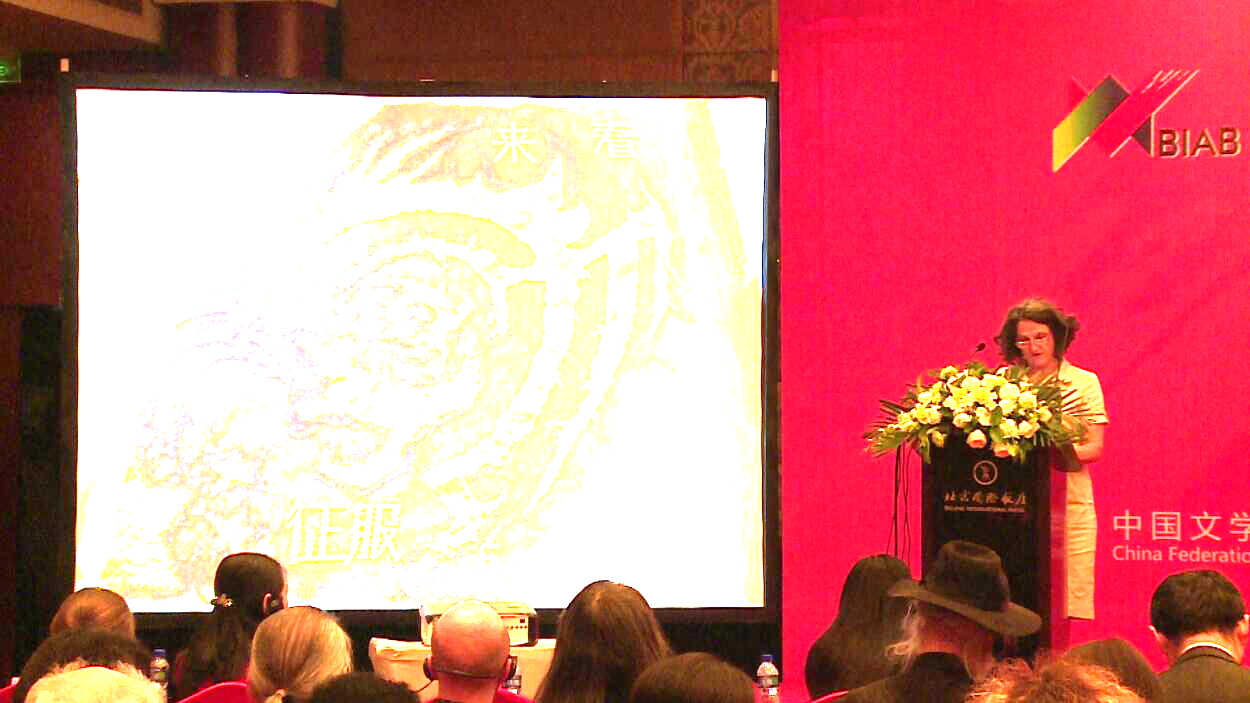
Nada Cakar, an artist from Croatia is delivering a speech
The theme of Nada Cakar is Dream and Discipline, she pointed out that: “Dream is the first place where artistic work takes place. As a matter of fact the majority of my artworks first appear in my dreams. Afterwards, most of the time, I merely try to solve technical challenges in order to materialize the installation from the dream into the physical reality. There is so much energy built in every project in form of self-discipline and hundreds hours of hard work. As far as I am concerned pure art seems to be about one minute of a dream and billions of minutes of hard work since I tend to make long-term projects that last from half a year to more than a year. In my point of view art carries a huge responsibility. Still, responsibility does not exclude freedom. The highest level of freedom is to set self-boundaries. Artist does not have to run naked on the streets in order to attract attention and define it as an art performance and so on. The purpose of art is not to shock. Art has to gently force the spectator to stand still and to initiate emotions consequently leading to contemplation. With my art I want to influence in a positive way. I intend to tell stories that have an impact on the spectators. Art is also about transmission of energy. The artist puts energy into his work that is later being transmitted to the spectator. When an artwork captures your attention it forces you to stand still in front of it, that is the moment when you start a silent dialogue with the artwork and transmission of energy takes place and a relationship starts to develop.”
The theme of the 6th Beijing Biennale is “Memory and Dream” which struck many artists about their memories and dreams. Aleksei Shatunov is one of them. Excerpt from his speech The Perfect Formula to Success is as follows: “Memory and Dream is the topic of the 6th Beijing Biennale. Memory can be interpreted as a inviolable past, something that became a history and our experience. Dream – something that is meant to be, things to come. Our goal and guiding line that leads to success. If you take away a mankind’s ability to dream, it will destroy one of the most powerful motivation reasons that creates culture, art, science and will to fight for beautiful future. During the process of creating I often lean on the cultural background of different countries, their history, mythology and folklore. Big and tiny peculiarities of every nation attract my attention and interest me the most. The human perception of visual art is based on associations and personal memory of a viewer. The painting (sometimes) touches the viewer and evokes the right emotions by personal associations (frequently it happens subconsciously), or leaves the viewer indifferent, due to the lack of personal associations. Many times even a very well done painting technically might leave a person uninterested. So, we can imagine some of the paintings as a bottle filled with subconscious memory of the artist, which is opened by the viewer. When the memory of the artist and the viewer’s match, the viewer receives right emotions that artist was trying to show.”
Miroslav Mandic, an artist from Serbia takes Contemporary Art Battle, Without Victims as his theme of speech. He highlighted that art makes us good and pointed out that: “We, as a society, through art or acts can influence and make this world a better place to live in. We must work to discard any negative feelings such as envy, greed and false aspirations and never forget the feelings, emotions, compassion and originality. Ego is an obstacle, by absence of ego we can become a channel for implementing ideas. If our idea is noble, we can accomplish miracles. I agree with artist who said: it is not that important whether we are doing painting, sculpture or installation, but it is important from which state of mind we do what we do. We can learn a lot from the great world scientist Nikola Tesla who was a living example of the influence of how dreams can become realities, and which were in the service of humanity not the individual. In this way can every participant fights for freedom in the Contemporary Art Battle and leave no victims behind.”

Rémy Aron, President of the Société des Artistes Fran?ais is delivering a speech
Rémy Aron, President of the Artists Association in France is an old friend of the China Artists Association. He provided strong support for China when he served as the financial minister of the International Association of Art. This time, he delivered a speech on Relationship between the Art Creation Moment and “Memory and Dream”. He expressed that: “All artists are trying to exhaust resources in their paintings, and look for the relationship and correspondence between shape and color, and the rhythm in the limited palette with their profound, strong and organized desire. To plastic artists, our language is not the one that defines or classifies things, but shapes that are moving and interacting with the whole, to find out the harmony in part of or the whole of an image. Life of human beings and of artists always stays at this moment and this place. Tragedy on the stage of palette has put on as a messenger between memory and dream. The artists wish to present a harmonious space at some time in the future.”
The theme for Marc Baufrère, an artist from France is My memory and Dream. Excerpt from his speech is as follows: “Everyone dreams, all human beings all over the world have dreams and they also all have memories. In my opinion, there are not that many differences in the dreams of people from one country or another. Of course the cultural education of each person is not the same and has some influence on his or her perception of reality, but so has your gender, your parents, the era you live in and I only mention some of the major elements that make us who we are…….,but in regard to Death all these differences are nothing.
I think that every human on earth has the same, most important dream is to kill death and for me Art is an attempt to do that! I want to emphasize the universal and unique value of artworks as a true expression of the dreams and memories of mankind. I think it is very important as an artist to create new vision, to give the viewers a new comprehension of life, a new interpretation and a new style. At the beginning of the 20th century, the surrealist movement made an attempt to give a reality to dreams in their paintings. My paintings are closely related to this research and are inclined to discover the New.”
Exploration for Artwork Creation under Diversified Artistic Pursuit
Gary Stern, who is a teacher at Technical & Vocational College in Zurich delivered a speech on Line & Point, a Research into Connecting Memory and Dream by Artistic Practice based on his own experience on learning Chinese traditional water and ink painting. Excerpt from his speech is as follows: “My work researches the human condition, while maintaining a reference to our collective origins and dreams as a conceptual axis. Subsequently it deals in a critical way with human relations and with questions of identity, migration and ecology. I had always been deeply interested in classical western philosophy and artistic concepts. In 2014, on the occasion of my first visit to Red Gate Residency in Beijing, China, I hesitated whether to work in my traditional media, I started researching Chinese ink and paper. This encounter, plus the immense flood of impressions in China, challenged my artistic understanding. I realized that the difference in eastern and western approach to the LINE and the POINT will be the creative foundation-stone of yet deeper research into the fusion of antithetical artistic concepts.”
When Han Xuezhong, Researcher at the Chinese Painting Institute under the Chinese National Academy of Arts talked about the process of his creation Harmonious Hometown, Expectation, he is very emotional. What he expressed during his speech is as follows: “In 2010, my students and I went to Qiaoshang Village in Pingshun County, in Shanxi Province to experience village life and carry out some scenery painting. A lot of people and experiences touched us. Together they gave us unforgettable memories. Like many villages in China, young and middle-aged male adults left for the cities to earn more money, while women, children and the old were left behind. This is exactly the source of my painting: an ordinary peasant family. A great-grandmother, a grandmother and a grandson, three of four generations stand at the doorway and pose for a photograph. Encouraged and moved by their simplicity, passion and persistence, I created this work, titled Harmonious Hometown, Expecting. Expecting tells not only about waiting and anticipation but also responsibility.”
Kong Zi, Chairman of the China Female Artists Association extended her femininity when she described her artwork series Memory. She mentioned that: “Memories and dreams are life’s most precious gifts. Each individual is a mere speck in the world, and each of our own individual experiences isn’t all that significant. Still, our experiences make us who we are. The memories reserved in one’s mind from experience are the radiant parts, filtering away the dark and excessive details, and are poems created by the softest parts of one’s life. The painting series Memory is about my impressions of my childhood hometown and its impact on my life. A memory is the fruit of childhood and innocence. Chuang Zhou said, “A perfect man does not dream,” so a man with dream is “immature.” However, I believe there is good in having dreams. I like the youthfulness and pureness brought by dreams and appreciate the obsession and effort it takes to have them.”
Liu Xuanrang, Professor at the Chinese Painting Institute under the Chinese National Academy of Arts does well in creating artworks on Xinjiang. He mentioned in his speech Tracing the Vicissitudes of a Cultural Cradle and Opening Dialogue on Art that: Anthropologist Morgan once said “The Tarim River along the Silk Road is the cradle of the world’s culture. Once this key is found, the door of world’s culture will be opened.” Fourty years ago, because of my specialty in painting, I joined the army and came to Xinjiang, a mysterious land, and began my decades-long cultural pilgrimage. Over the past 40 years, I experienced the good and the bad of this land, and my brushes recorded all of it. The creative linguistic schema of Chinese painting captures the spiritual sound of the Silk Road – the most marvelous moment of the “Twelve Muqam” which is listed as World Intangible Cultural Heritage. This is a dialogue between history and the future at a spiritual level, and the result of my decades of exploration and research on the humanistic spirit of the Silk Road, which I believe will be a key to opening the door to further international cultural exchange.
The year 2015 marks the 70th anniversary of the end of the War of Resistance against Japanese Aggression and the end of World War II, Wang Zijiang, a Chinese painter reside in Japan submitted his artwork Late Confession for the 6th Beijing Biennale and told the story of an old Japan solider. In his speech, he expressed: “In the nearly 30 years of living in Japan, I was often invited to all kinds of art lectures and discussions. This is how I met Shunichi Iida, a character in my artwork. He was a Japanese soldier who died during the Chinese People’s War of Resistance against Japanese Aggression. During the war, he was a civilian staff in the army. He didn’t fight in battle directly but witnessed the brutal practices of the Japanese army. For years after the war, he never talked about that time with his family and kept the memories to himself, despite the internal suffering it caused. He never did return to China, something that would have caused him immense pain. He used to say that Japanese literature and arts all come from China, and that he wished China and Japan would build an everlasting friendship and never again return to war.”
The subject for Lu Shengzhang still focused on wars, but he described the Koran War, which happened in about 60 years ago, not long from now. The work Expectation is about the memories of resisting the U.S. Aggression and the help in combat given to North Korea over 60 years ago. Excerpt from his speech is as follows: “Expectation is a thematic statue in the memorial park for the unknown Korean volunteer soldiers. The statue uses granite and stainless steel, and is made by hand using circular engravure, embossment and mural. The inspiration of this work comes from the waving Himalaya Mountains. The shape of mountains illustrates the mountains’ character, which is a metaphor for the soldiers’ spirits. It tells of the expectation of soldiers returning home and world peace, and provokes us to reflect on war, peace and humanity.”
The artworks created by Shen Jiawei, an Australian Chinese artist are mainly about historical subjects. His works are different from other pure realistic works as he also assimilates surrealism. In his speech I Met My Memories in My Dreams, he started with his artwork Spain 1937 and excerpt from his speech is as follows: “I’m a professional history painter, so my works are naturally categorized as being of “Memory.” History is the shared memory of humanity. It shapes today and will influence tomorrow, so the concept of a “Dream” is closely connected with that of “Memory.” As for my personal experience, I’m forever a young man in my dream and always encounter my memories in my dream. History painting is extremely marginalized in today’s world. One of the reasons is that film, the art form that matured in the 20thcentury, has well replaced the role played by history painting in the 19th century. However, the “depiction of figure” remains the irreplaceable core element in history painting. In the 20th century, modernism and postmodernism have engaged in countless experiments. Based on this rich experience, history painting in the 21st century has gained considerable freedom. The image itself creates impacting effects and inspires audiences.”
Karen von Veh, a British native and now she is a professor of the University of Johannesburg. She is familiar with history of the contemporary and modern South Africa and she delivered a speech with the theme of South African Art in a Time of Democracy: a Curator’s Thoughts on the Exhibition. Excerpt from her speech is as follows: “In this paper I explain the curatorial choices we have made in terms of showing artist’s responses to South Africa’s 21 years of democracy. I also discuss our policy of ‘democratic curatorship’, a term coined by Gordon Froud, to express our wish to present both established well-known artists and certain young emerging artists; who we believe are embarking on successful careers and who have something pertinent to say about the condition of our society for the future of the youth. All the artists selected acknowledge the role of contemporary art in South Africa as a catalyst for change and raise social and political issues both good and bad. Their work comments on the real impact of twenty-one years of democracy - a democracy which has allowed them the artistic freedom to comment incisively on some of the continuing challenges arising from inherited and ongoing inequality in society.”
Matthew Brower and Zhou Yan, Curators of the Special Exhibition of Canada separately delivered a speech from different perspectives, contemporary artistic development in Canada and cultural exchange between China and Canada. The theme for Matthew Brower is Mediated Memory in the context of Contemporary Canadian Art and excerpt from his speech is as follows: “Canadian art is largely understood as consisting of a series of regional art scenes (centered in key Canadian cities) that have developed to varying degrees in response to their local histories, a larger national conversation, and broader currents in global art practice. The major regional scenes are the west coast, the prairies, Ontario, Quebec, the Maritimes, and the Arctic. Cutting across the regions there is also a national practice of contemporary indigenous art growing out of the woodlands school of painting (Norval Morrisseau). The current show contains representatives from all of the regions except the Maritimes and the Arctic.”
Zhou Yan, curator of the Special Exhibition delivered a speech on Exploration and Exchange of Cultural Memory in Media and Globalized Society. The following is excerpt from her speech: “During the past four decades, Canadian art presence in China has not been very frequent, but played a significant role in Chinese contemporary art development. Exhibitions such as the Group of Seven, Alex Colville, Edward Burtynsky, Jeff Wall and the last year’s group show The transformation of Canadian Landscape Art have profound impacts onto Chinese art world and society. Mediated Memory is conceived under the theme “Memory and Dream” of the 6th Beijing Biennale, exploring cultural memory that is expressed in hidden or direct ways in contemporary media and globalized society. Through this exploration, the exhibition presents the inheritance and transformation of Canadian art, its response to global culture, and Canadian multi-culture features.
Beijing Biennale in the Eyes of Others
Nguyen Mai Huong, member of the Vietnam Artists Association apparently has an in-depth research and understanding the Beijing Biennale. In her speech What Memory and Dream Can Mean to the Artists Today ? , she expressed: “The Beijing Biennale is one of the world’s most famous and highly qualified Biennale. Beijing Biennale is a large-scale international art exhibition where all the most creative artists can gather to express their ideas and abilities. It is a great opportunity to show China’s hospitality and its great art history and colorful culture. The purpose of the Beijing Biennale is to connect the artists from generations to generations to develop arts. The 6th Beijing Biennale with its theme “Memory and Dream” is a great event that links history with reality, connects the past and the future, and could be best placed to reflect the humanistic care of artists, arouses their passion to paint and inspire artists’ aesthetic imagination, so that art works can be as lasting as memories and as magical as dreams. Although Chinese artists are really skillful, deeply understand how to capture the reality and to bring their traditions into their artworks, some lack of the contemporary elements. It’s is the reason why we also need Dream. Dreams make new ideas. “New ideas’ is the bridge that connects us to the future. Artists from different countries gather to create works and share ideas. Artists in every country in the world bring with them their unique historical and cultural memories, along with their dreams. They all come to share the dream of partnerships and long-term developments between different countries. The Beijing Biennale helps us all to head to a bright future, where all our dreams can come true.”
Lin Xiangxiong, President of the Global Chinese Arts and Culture Society and Curator of the 6th Beijing Biennale connected his interpretation of the Road and Belt Initiative with the Beijing Biennale. In his speech Culture and Art VS the “Belt and Road”: Speaking from the Beijing International Art Biennale, he expressed: “Chinese President Xi Jinping announced to the world, in a way combining romanticism and realism, that the “Belt and Road” economic and development blueprint for the 21st century is based on the “Silk Road” of the Han Dynasty. It has aroused intense reaction not only from the international community but also in culture and art circles. This strategy is no doubt a development in political and economic thought, but it also covers culture and art. Judging from domestic and world history, political power and fortune all have space and time limits, but culture and art do not. Particularly, nationality and ethnicity can be passed on and win over the people with virtue only when they are deeply rooted in culture and art. Art has no boundary. The rich accumulation of Chinese culture and art, especially in the communication of art between the West and the East and their integrated development in the last hundred years, has showed an integration and innovation featuring unity in diversity. Fine art is an important part in the field of art and its qualities of being “boundary-less” and “barrier-free” allow for a visual enjoyment and spiritual understanding. Fine art is an “advance force,” and the Beijing International Art Biennale serves as a communication platform for that force.”
In the free talk section of the symposium, many artists took the hard-won opportunity to introduce and present the cultural tradition and contemporary artistic development in their own country and expressed their wishes and expectation of the Beijing International Art Biennale.
Tao Qin, Vice Secretary General of the China Artists Association pointed out that in the summary: The organizing committee attached great importance to the symposium which is held in every session of the Beijing Biennale. Through the symposium, artists and representatives of the organizing committee of the Special Exhibition from all over the world can conduct a deep communication with each other. Many artists are recommended by the foreign embassies in China and Chinese embassies in foreign countries and some of them even got the financial support of these embassies to come to China to attend the exhibition. The Embassy of Vietnam specially held a meeting to help those selected artists to prepare for coming to China. The symposium of this year gathered the wisdom and achievements of a lot of international artists and they all expressed their perceptions of the Beijing Biennale, which will inspire the organizing committee to think about its future plans and also cover many subjects of contemporary art. We really hope that after you come back to your home country, please tell other artists about your experience in China as the reason behind the reputation of the Beijing Biennale is by words of mouth and it has attracted more and more artists to participate into the exhibition.
In the end, Shao Dazhen, the host of chief of the symposium delivered a concluding speech. He talked about his feeling and thought that the 6th Beijing Biennale interpreted the theme of “Memory and Dream” from different perspectives, different national cultural backgrounds and artistic development. Artworks of foreign artists gave inspirations to Chinese artists with its different philosophy. The symposium is a beautiful memory of every audience and artist. He hopes that the Beijing Biennale and the international academic symposium during every session will continue its original intention, that is, Beijing Biennale was and always will be the bridge and platform for artists from home and abroad.
